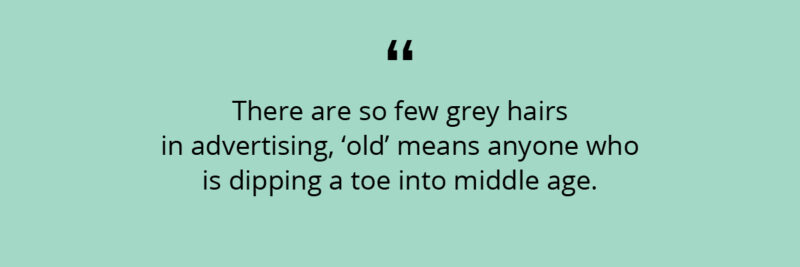Ageism in Advertising is a series designed to tackle the neglected issue of ageism in Canada’s advertising industry. The vast majority (70%) of people in agencies are aged 40 or younger. Rebalancing this towards a fairer representation of age groups across the board will not only improve creativity and inclusivity but also help to address our talent crisis.
By Patrick Collister, Curator, The Caples Awards, Non-Executive Creative Director, Ad-Lib Digital and Coach, Creative Matters
Azeem Rafiq is a professional cricketer who has sent shockwaves through every sports organization in the UK.
In November, he told a UK parliamentary committee that he had been the victim of racial abuse not just occasionally but throughout his entire career at Yorkshire Cricket Club.
He mentioned that on the day he and three other players of Asian origin stepped out proudly to play for Yorkshire, the captain, Michael Vaughan, said: “There are too many of you lot, we’ll have to do something about it.”
Vaughan has said that there isn’t a racist bone in his body.
And he’s sincere. But that’s because racism has become so commonplace no-one notices any longer. Except the victims.
“You lot” is Vaughan’s idea of banter. It is, in fact, discriminatory and alienating.
I tell this story of opaque prejudice because though I’m white, male and straight (sorry), I’m a casualty of another equally pervasive form of discrimination.
I’m over 60, you see.
When I was at Google, I helped organize a small conference about diversity and inclusivity.
The speakers were black, gay and people with disabilities. In their speeches, every one of them said, “At least I’m not old.” They were being funny. They got laughs.
It was unconscious bias, it was alienating and nobody noticed. Except me.
It prompts an interesting question. How old do you need to be to be a victim of ageism?

Incredibly, there are thirtysomethings in agencies who say they’ve suffered. And in the film “The Internship”, the joke is that Owen Wilson and Vince Vaughn are too old to get jobs at Google because they’re in their 40s. For heaven’s sake. In other words, there are so few grey hairs in advertising, “old” means anyone who is dipping a toe into middle age.
It’s an issue that persists across many of the world’s most prominent advertising markets. For instance, ICA Talent Census data in Canada revealed in 2020 that just over 70% of respondents were 40 years old or younger. Only 11% of the workforce was older than 51 – a considerably lower proportion than the broader labour market in which Canadian workers over 50 account for 35.42%.
Meanwhile, 36% of people in the global marketing industry agreed that age can hinder their career at their company. More people in both the US (42%) and Canada (40%) agreed with the statement, according to the report from the World Federation of Advertisers.
And in the UK in 2020, with thanks to the IPA, 78.1% of the industry was under 40, up from 77.9% in 2019. In other words, Covid is allowing adland to jettison even more of its older practitioners.
The irony is that there is a reported “talent crisis” in agencies.
There’s a crisis alright. Just look at any advertising break or peer at the banners on any major website. The ads are awful. So awful that the whole business model that supported broadcast media is now collapsing.

People would rather pay more for streaming than be subjected to 20 minutes of commercials every hour. Commercials which, for the most part, are noisy and unpleasant.
As for online, well, it tells you something that a billion phones and pads now have ad-blockers installed.
It’s not just that the ads are pollutants, people think they are lies. A 2020 survey showed that 30% of Canadians believe newspaper advertising cannot be trusted at all. The presumption is that the people who make them are awful too.
The crazy thing is that the talent exists to make ads that people might actually enjoy watching. That might just save the industry. It’s just that it’s been put out to pasture by managers anxious to protect and preserve their own wage packets.
I can think of one gifted copywriter who now teaches at a provincial university. Another art director has become a wedding photographer. One former executive creative director has been driving the tour bus for a rock band.
Meanwhile, agencies rely on relatively callow young creative teams to solve big problems. And they struggle.
One unpublished report I’ve heard about has found that agency creatives have been more depressed and more troubled during Covid-19 than average. A creative who lives near me says that he hasn’t been working from home but sleeping at work. The pressure is intense but at the ripe old age of 40, he’s the sage of the department. There’s no-one with more experience.
Clients notice. They’re beginning to peer closely at resource plans when agencies pitch for their business. And they’re moving more and more money to the consultancies and to influencers. As Marc Pritchard, Chief Brand Officer at P&G has observed, ads are all too often “just silly, ridiculous or stupid.”
The interesting thing to me is that many of the young creatives I speak to don’t seem to care if the work is good, bad or indifferent. In 2019, a survey by independent agency Impero suggested that 60% of people under 30 in London agencies were actively looking for jobs outside the industry.
Whereas old weirdos like me are obsessed with it. Still. And there are many of us.
Former creative luminary Andrew Cracknell was going to start an agency called Long Trousers and rope in all his old mates from yesteryear.
And, you know what? It might even have worked. But he thought better of it. Young marketing directors want to work with young creative directors. Reap as ye shall sow, as the good book says.
If anyone’s interested, you can see my reel HERE. I’m fast, I’m good and I’m available. Just invisible.
Patrick Collister is a partner of the Institute of Canadian Agencies. Report on Marketing is where leading Canadian agencies showcase their insights, cutting-edge research and client successes. The Report on Marketing provides a valuable source of thought leadership for Canadian marketers to draw inspiration from. Find more articles like this at the Report on Marketing.




